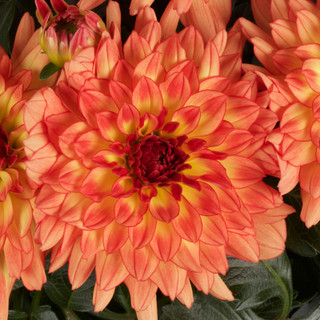
Red Hot Poker
Uses:
- Pollinator Gardens
- Next to Sidewalks & Roads
- Thriller in Containers
Features:
- Unique Bright Blooms
- Deer & Rabbit Resistant
- Drought & Salt Tolerant
Sunlight:
- Full Sun
- 6+ Hours of Direct Sun
Growing Zones:
- 5-9
- What is My Zone?
Red Hot Poker plants have tall unique flowers that attract hummingbirds, butterflies & bees. Plant next to sidewalks & roads in full sun locations for added curb appeal in the harshest of locations in the yard.
Why Buy Red Hot Poker Online?
Red Hot Poker are flowering perennials from Africa that have narrow, grass-like leaves. The showy flowers, often multicolored in red, orange, and yellow, grow on upright spikes. The flowers produce a large amount of nectar and attract bees, sunbirds, hummingbirds and New World orioles. These plants are extremely hardy and can handle full sunlight, harsh winters, and salt.
Tall bright attractive blooms
Low maintenance
Flowers are red, orange, yellow
Great next to sidewalks and roads
Growing zones 5 to 9
About Red Hot Poker

Torch Lily, Tritoma, Knofflers, and Poker Plants
South Africa, Lesotho, Eswatini
Perennials
Semi-Evergreen, Deciduous, Herbaceous
5 - 9
Red, orange, yellow
Mid-summer to fall
Clumping, Spreading, Upright
Bees, Hummingbirds, Butterflies
Drought, Heat, Salt
Deer, Rabbits, Voles, Moles, Diseases, Pests
How To Use Red Hot Poker In The Garden
Red Hot Poker plants (Kniphofia) send up torch-like flower spikes in shades of red, orange, and yellow. These tubular flowers are arranged densely atop tall, slender stems, creating a dramatic visual display in gardens. The blooms are also rich in nectar and highly attractive to pollinators such as hummingbirds and butterflies. The plant's long, narrow, grass-like leaves form clumps at the base and add texture and architectural interest.
The bold flower spikes of Red Hot Pokers provide vertical interest and make excellent focal points in mixed borders or as striking accents in perennial beds. They pair well with plants like Echinacea and ornamental grasses, offering contrasting forms and complementary colors. Additionally, their drought tolerance and preference for full sun make them suitable for xeriscaping and low-maintenance landscapes.
Red Hot Poker Care
Red Hot Poker requires full sun exposure, with at least six hours of direct sunlight daily. After planting, water thoroughly and continue to provide about one inch of water per week during summer months, allowing the soil to dry out between waterings. While these plants are somewhat drought-resistant, regular watering promotes optimal flowering. A light fertilizer application in the spring can be beneficial.
Pruning Red Hot Poker involves removing spent blooms after they fade to encourage continuous flowering. Leave the foliage intact through the winter, as the leaves protect the crown from wet, cold conditions. In early spring, old foliage can be cut back to about three inches to prepare for new growth. When growing in containers, select a dwarf variety and use a pot with drainage holes. Before the first freeze, move the container indoors to enjoy as a houseplant over the winter.
Learn More About Red Hot Poker Care

Red Hot Poker Companion Plants
Plants that go well with red hot poker are sun loving annuals, perennials and shrubs. Some of our favorite plants to grow with red hot poker are dahlias, daylilies, baptisia, coneflowers, sedum, arborvitae, and ornamental grass.










